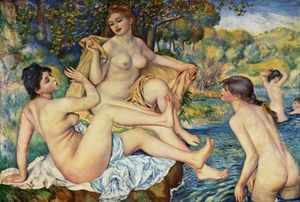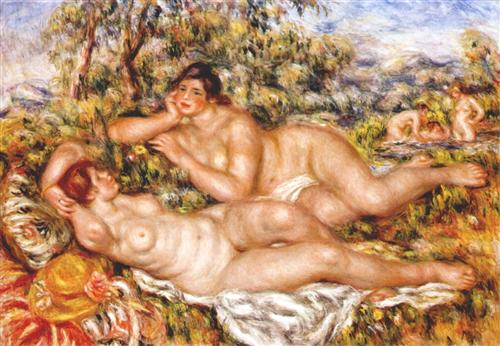
Much is written and available about Pierre-Auguste Renoir, one of the most influential Impressionist artists of the 20th century. Thus in honor of his 174th birthday, instead of writing about his achievements and art, presented instead is a list of some interesting and little known facts about him. They will hopefully create a better perspective of the man who celebrated beauty and light, and encourage further exploration into his amazing life.
Fact 1: Of all the Impressionist artists, it was Renoir who was most interested in painting humans and studying the portrayal of human emotions. Very often there is a sense of emotion in a scene he’s captured which comes from the figures in the scene and their behavior.

Fact 2: In 1881 Renoir feared that he had been so swept up in Impressionism that he had forgotten how to paint properly. To rectify this he traveled to Italy, studying the classical art of the Renaissance painters like Raphael, which inspired him to create paintings with more solid definition and a specific focus. He emphasized volume, form, contours, and lines rather than color and brush stroke. His works from this time onward have been grouped together under the title of the "Ingres" period, reflecting their slight similarity to the technique of Ingres. This period is also known as Renoir's "harsh" or "dry" period.
Fact 3: Renoir participated in Queen Victoria's Golden Jubilee even though he was not a British citizen at the request of one of the queen's associates. Renoir was asked to provide a number of paintings to the "French Impressionist Paintings" catalog as a sign of the artist's loyalty.

Fact 4: Renoir developed severe rheumatoid arthritis later on in life which confined him to a wheelchair. In the advanced stages of his condition, he strapped a paint brush to his paralyzed fingers so that he could continue to make art. Up until his death in 1919, Renoir spent a lot of time on one large-scale composition ‘The Great Bathers (The Nymphs)’ as well as sculpting, by directing his assistant in what he wanted to accomplish.
Fact 5: Just before his death in 1919, Renoir saw one of his canvasses displayed next to the work of his hero Paolo Veronese in the Louvre.
Fact 6: The single largest collection of Renoir's works is not in his home country of France, but rather at the Barnes Foundation in Pennsylvania where a total of 181 paintings currently reside.
.jpg!Blog.jpg)
Fact 7: Renoir's joyful depiction of an open-air dance hall in Paris, "Au Moulin de la Galette," is his highest publicly sold work of art, selling for $78.1 million. This makes it the 9th highest painting ever sold to this date and the artist part of an exclusive group that includes Van Gogh, Picasso and Gauguin.
